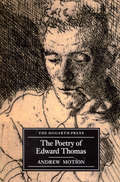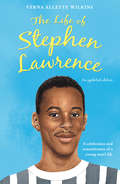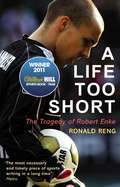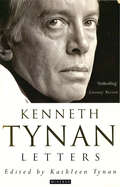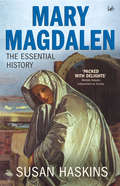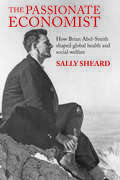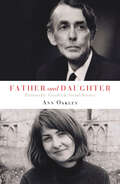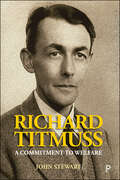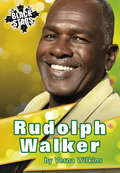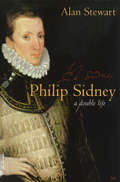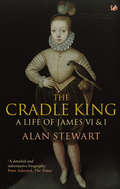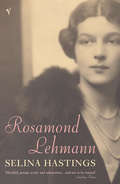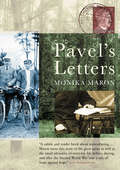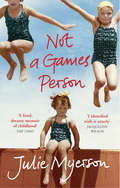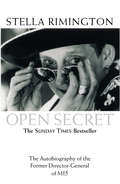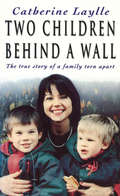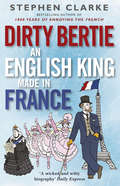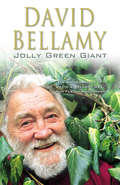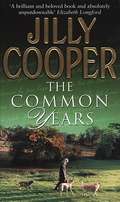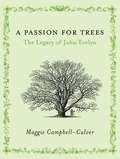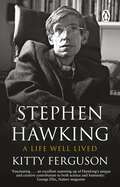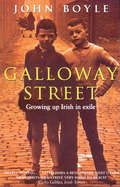- Table View
- List View
The Poetry Of Edward Thomas
by Andrew MotionWhen Edward Thomas died at Arras in 1917 few people thought of him as a poet. Yet in the two years before his death, after a lifetime writing prose, Thomas wrote some of the most enduring poems of his day: poems of war, nature, friendship, despair and exultation. Andrew Motion's pioneering study of Thomas' life and achievement is scholarly yet utterly absorbing, combining an account of his struggles as a writer with perceptive readings of individual poems.Andrew Motion's books include a biography, The Lamberts, George, Constant and Kil, and several prize-winning collections of poetry, the most recent of which is Love in a Life. He is currently writing the authorized biography of Philip Larkin.
The Life of Stephen Lawrence
by Verna Allette WilkinsStephen Lawrence was a bright, athletic, young man with high hopes for the future. He lived in south-east London with his parents, younger brother and younger sister. On 22 April 1993, he was brutally murdered while he was waiting for the bus. He was eighteen years old. He didn't know his killers; his killers didn't know him.This is his story. He will be remembered.This paperback edition revised with added material about the trial, the legacy of Stephen Lawrence and a final note from Doreen Lawrence.
A Life Too Short: The Tragedy of Robert Enke
by Ronald RengWINNER OF THE WILLIAM HILL SPORTS BOOK OF THE YEAR WINNER OF THE BRITISH SPORTS BOOK AWARDS FOOTBALL BOOK OF THE YEAR Why does an international footballer with the world at his feet decide to take his own life? On 10 November 2009 the German national goalkeeper, Robert Enke, stepped in front of a passing train. He was thirty-two years old and a devoted husband and father. Enke had played for a string of Europe's top clubs, including Barcelona and Jose Mourinho's Benfica and was destined to become his country's first choice in goal for years to come. But beneath the veneer of success, Enke battled with crippling depression. Award-winning writer Ronald Reng pieces together the puzzle of his friend's life, shedding valuable light on the crushing pressures endured by professional sportsmen and on life at the top clubs. At its heart, Enke's tragedy is a universal story of a man struggling against his demons.‘It should be on every British football fan's reading list’ Metro
Tynan Letters
by Kathleen TynanThe Letters of Kenneth Tynan- drama critic, talent snob, intellectual dandy, inveterate campaigner - provide a record of a soul: written between the ages of 11 and 53, they not only chart the extraordinary parabola of his career but show the constancy of his quest for grace, style and effortless wit.
Mary Magdalen: Truth and Myth
by Susan HaskinsA dramatic, thought-provoking portrait of one of the most compelling figures in early Christianity which explores two thousand years of history, art, and literature to provide a close-up look at Mary Magdalen and her significance in religious and cultural thought.
The Passionate Economist: How Brian Abel-Smith Shaped Global Health and Social Welfare (LSE Pioneers in Social Policy)
by Sally SheardBrian Abel-Smith was one of the most influential expert advisers of the 20th century in shaping social welfare. He was a modern-day Thomas Paine, driven by a strong socialist mission to improve the lives of the poorest. This valuable and accessible book is the first biography of Abel-Smith. It takes a historical perspective to analyse the development of health and social welfare systems since the 1950s, exposing the critical impact of long-running debates on poverty and state responsibility, especially in Britain. This book also provides the first comparative study of how developing countries sought better health and social welfare, enabled by the World Health Organization and other agencies for whom Abel-Smith regularly worked. This book offers an engaging and useful study for students and researchers in health and social policy, history, politics and economics and interested general readers. It will also be essential reading for professionals working in those government ministries and institutions that Brian Abel-Smith helped to shape. LSE Pioneers in Social Policy Brian Abel-Smith, Richard Titmuss and Peter Townsend, all based at the London School of Economics and Political Science, made major contributions to the development of policies on the elderly, health care, law, poverty and welfare in the 20th century. This series of biographies tells the stories of these outstanding individuals: their backgrounds, ideas and work.
Father and Daughter: Patriarchy, Gender and Social Science
by Ann OakleyFather and daughter provides an unique ‘insider perspective’ on two key figures in twentieth-century British social science. Ann Oakley, a highly respected sociologist and best-selling writer, draws on her own life and that of her father, Richard Titmuss, a well-known policy analyst and defender of the welfare state, to offer an absorbing view of the connections between private lives and public work. Using an innovative mix of biography, autobiography, intellectual history, archives, and personal interviews, some of which have not been previously available to the public, she provides a compelling narrative about gender, patriarchy, methodology, and the politics of memory and identity. This fascinating analysis defies the usual social science publications to offer a truly distinctive account which will be of wide interest.
Richard Titmuss: A Commitment to Welfare (LSE Pioneers in Social Policy)
by John StewartThis is the first full-length biography of Richard Titmuss, a pioneer of social policy research and an influential figure in Britain’s post-war welfare debates. Drawing on his own papers, publications, and interviews with those who knew him, the book discusses Titmuss’s ideas, particularly those around the principles of altruism and social solidarity, as well as his role in policy and academic networks at home and overseas. It is an enlightening portrait of a man who deepened our understanding of social problems as well as the policies that respond most effectively to them.
Lockdown Life: The Pandemic Experience for Older Diarists
by Nicola MadgeThe COVID-19 pandemic took many by surprise when it arrived in Britain in early 2020. Daily lives changed dramatically from March with the introduction of unprecedented restrictions and lockdowns. How did people react? This book draws on the diaries of 68 men and women aged 70 and above, capturing their thoughts and experiences over the following months. Although these older diarists considered themselves among the more fortunate at the time, their entries reveal both highs and lows. There were anxieties and frustrations but also much positivity and, often, a reluctance for an over-hasty return to pre-pandemic times. Through these personal and contemporaneous accounts, the book offers a unique contribution to our understanding of the pandemic and its significance in modern social history.
Rudolph Walker Biography (Black Star Series #3)
by Verna Allette WilkinsThe life story of Rudolph Walker, an actor whose career on stage and television in the UK spans 42 years. Includes photographs, illustrations and exclusive interviews. Rudolph was born in Trinidad in the Caribbean. When he was only 20 years old he left the island for London, to embark on a career in theatre. He is best known for his role as Patrick in EastEnders but worked on many popular TV series including Love Thy Neighbour, The Thin Blue Line, Black Silk and The Crouches. He has appeared on stage at the Old Vic, the Young Vic, the Tricycle, the Royal Court and the Theatre Royal among others.
Philip Sidney: A Double Life
by Alan StewartCourtier, poet, soldier, diplomat - Philip Sidney was one of the most promising young men of his age. Son of Elizabeth I's deputy in Ireland, nephew and heir to her favourite, Leicester, he was tipped for high office - and even to inherit the throne. But Sidney soon found himself caught up in the intricate politics of Elizabeth's court and forced to become as Machiavellian as everyone around him if he was to achieve his ambitions. Against a backdrop of Elizabethan intrigue and the battle between Protestant and Catholic for predominance in Europe, Alan Stewart tells the riveting story of Philip Sidney's struggle to suceed. Seeing that his continental allies had a greater sense of his importance that his English contamporaries, Philip turned his attention to Europe. He was made a French baron at seventeen, corresponded with leading foreign scholars, considered marriage proposals from two princesses and, at the time of his tragically early death, was being openly spoken of as the next ruler of the Netherlands.
The Cradle King: A Life of James VI & I
by Alan StewartAs the son of Mary Queen of Scots, born into her 'bloody nest', James had the most precarious of childhoods. Even before his birth, his life was threatened: it was rumoured that his father, Henry, had tried to make the pregnant Mary miscarry by forcing her to witness the assassination of her supposed lover, David Riccio. By the time James was one year old, Henry was murdered, possibly with the connivance of Mary; Mary was in exile in England; and James was King of Scotland. By the age of five, he had experienced three different regents as the ancient dynasties of Scotland battled for power and made him a virtual prisoner in Stirling Castle. In fact, James did not set foot outside the confines of Stirling until he was eleven, when he took control of his country. But even with power in his hands, he would never feel safe. For the rest of his life, he would be caught up in bitter struggles between the warring political and religious factions who sought control over his mind and body. Yet James believed passionately in the divine right of kings, as many of his writings testify. He became a seasoned political operator, carefully avoiding controversy, even when his mother Mary was sent to the executioner by Elizabeth I. His caution and politicking won him the English throne on Elizabeth's death in 1603 and he rapidly set about trying to achieve his most ardent ambition: the Union of the two kingdoms. Alan Stewart's impeccably researched new biography makes brilliant use of original sources to bring to life the conversations and the controversies of the Jacobean age. From James's 'inadvised' relationships with a series of favourites and Gentlemen of the Bedchamber to his conflicts with a Parliament which refused to fit its legislation to the Monarch's will, Stewart lucidly untangles the intricacies of James's life. In doing so, he uncovers the extent to which Charles I's downfall was caused by the cracks that appeared in the monarchy during his father's reign.
A Good African Story: How a Small Company Built a Global Coffee Brand
by Andrew RugasiraSince it was founded in 2003, Good African Coffee has helped thousands of farmers earn a decent living, send their children to school and escape a spiral of debt and dependence. Africa has received over $1 trillion in aid over the last fifty years and yet despite these huge inflows, the continent remains mired in poverty, disease and systemic corruption. In A Good African Story, as Andrew Rugasira recounts the very personal story of his company and the challenges that he has faced – and overcome – as an African entrepreneur, he provides a tantalising glimpse of what Africa could be, and argues that trade has achieved what years of aid have failed to deliver.This is a book about Africa taking its destiny in its own hands, and dictating the terms of its future.
Rosamond Lehmann: A Life
by Selina HastingsThe life of Rosamond Lehmann was as romantic and harrowing as that of any of her fictional heroines. Her first novel, the shocking Dusty Answer, became wildly successful launching her career as a novelist and, just as her novels depicted the tempestuous lives of her heroines, Rosamond's personal life would be full of heartbreaking affairs and lost loves. Escaping from a disastrous early marriage Rosamond moved right into the heart of Bloomsbury society with Wogan Philipps. Later on she would embark on the most important love affair of her life, with the poet Cecil Day Lewis; nine years later he abandoned her for a young actress - a betrayal from which she would never recover. Selina Hastings masterfully creates a portrait of a woman whose dramatic life, work and relationships criss-crossed the cultural, literary and political landscape of England in the middle of the twentieth century.
Pavel's Letters
by Monika MaronTeasing her family's past out of the fog of oblivion and lies, one of Germany's greatest writers asks about the secrets families keep, about the fortitude of ordinary people in extraordinary circumstances, and about what becomes of the individual mind when the powers that be turn against it.Born in a working-class suburb of wartime Berlin, Monika Maron grew up a daughter of the East German nomenklatura, despairing of the system her mother, Hella, helped create. Haunted by the ghosts of her Baptist grandparents, she questions her mother, whose selective memory throws up obstacles to Maron's understanding of her grandparents' horrifying denouement in Polish exile. Maron reconstructs their lives from fragments of memory and a forgotten box of letters. In telling her family's powerful and heroic story, she has written a memoir that has the force of a great novel and also stands both as an elaborate metaphor for the shame of the twentieth century and a life-affirming monument to her ancestors.
Not A Games Person (Yellow Jersey Shorts Ser.)
by Julie MyersonP.E. You either loved it or hated it, looked forward to it or dreaded it, but we've all been forced to do it. Sometimes a note could get you out of it, but the following week there you'd be again, writhing on a cold and dusty gym floor in your underwear. Skinny, timid, knock-kneed Julie Myerson was 'not a games person', according to her teachers. In this touching, funny and occasionally devastating exploration of her childhood, she now asks the question: why not?
Dear Fatty: The hilarious and heartwarming memoir from one of Britain's best-loved comedians
by Dawn FrenchA SUNDAY TIMES NUMBER ONE BESTSELLER___________________________The hilarious and heartwarming memoir from one of Britain's best-loved comedians and Women's Prize longlisted author, Dawn French.Dawn French is one of the greatest comedians of our time with a career that has spanned nearly four decades. Loved for her irreverent humour, Dawn has achieved massive mainstream success while continuing to push boundaries and challenge stereotypes. Here, she describes the journey that would eventually establish her as a perhaps unlikely, but nevertheless genuine, national treasure. As part of the much loved duo French and Saunders, Dawn helped create a repertoire of brilliantly observed characters, impersonating everything from Madonna and Harry Potter to The Exorcist. Dawn's iconic role in the Vicar of Dibley showcased not only her talent but also her ability to take a controversial and topical issue and make it mainstream - and very funny.From her early years as an RAF child and her flat-sharing antics with Jennifer Saunders, to her outspoken views on sizism and her marriage to Lenny Henry, Dear Fatty chronicles the extraordinary and hilarious rise of a complex, dynamic and unstoppable woman.
Open Secret: The Autobiography of the Former Director-General of MI5
by Stella Rimington'The story of MI5's transformation - is fascinating. So, too is Rimington's account of her rise in what was very definitely a man's world.' Guardian____________________________The eye-opening memoir from the first female Director-General of MI5Stella Rimington worked for MI5 between 1969 and 1996, one of the most turbulent and dramatic periods in global history. Working in all the main fields of the Service's responsibilities - counter-subversion, counter-espionage and counter-terrorism - she became successively Director of all three branches, and finally Director-General of MI5 in 1992.She was the first woman to hold the post and the first Director-General whose name was publicly announced on appointment. In Open Secret, she continues her work of opening up elements of the work of our security services to public scrutiny, revealing the surprising culture of MI5 and shedding light on some of the most fascinating events in 20th century history from the ultimate insider viewpoint.____________________________Stella Rimington is also the author of the novels At Risk and Secret Asset.
Two Children Behind A Wall
by Catherine LaylleIn 1984, Catherine Laylle, a Frenchwomen living in London, met and married a German medical student, Dieter. The couple had two sons, Alexander and Constantin. When, however, at Dieter's insistence, they moved back to his home town in Germany, the marriage began to fall apart. Dieter refused to get a job, Catherine found living with his family oppressive and eventually, she returned to London with the children. The boys spent term time with their mother, holidays with their father - until the summer of 1994, when Dieter decided that his sons should be raised as Germans and, with the support of the local judge, defied the London court ruling that gave Catherine custody. Catherine went to the courts in London, Germany and the Hague - but it seemed that no court outside the jurisdiction of Lower Saxony would overrule the decision. Today, Alexander is eleven and Constantin is nine. Catherine has barely seen them in the two years since Dieter kidnapped them - and then only under the supervision of one of his friends. This is the harrowing story of a mother's attempts to regain her children, and of her desperate struggle against a tyrannical family and the blind injustice of the courts in Europe.
Dirty Bertie: An English King Made in France
by Stephen ClarkeThe entertaining biography of Edward VII and his playboy lifestyle, by Stephen Clarke, author of 1000 Years of Annoying the French and A Year in the Merde.Despite fierce opposition from his mother, Queen Victoria, Edward VII was always passionately in love with France.He had affairs with the most famous Parisian actresses, courtesans and can-can dancers. He spoke French more elegantly than English. He was the first ever guest to climb the Eiffel Tower with Gustave Eiffel, in defiance of an official English ban on his visit. He turned his French seduction skills into the diplomatic prowess that sealed the Entente Cordiale.A quintessentially English king? Pas du tout! Stephen Clarke argues that as 'Dirty Bertie', Edward learned all the essentials in life from the French.
Jolly Green Giant
by David BellamyDavid Bellamy is a natural story teller whose memoir will be packed full of funny anecdotes and observations. It is the story of how a city boy, brought up in the middle of London, went for a trip into the countryside one day, an event which was to transform his life by setting in motion the amazing love of nature which would make famous this larger-than-life character. In his infectious style he illumines on, amongst other things, the fact that his father, the manager of a branch of Boots, had to grease his hair straight - because in those days managers of Boots weren't allowed to have curly hair! Then there was the time he and his brother discovered an exploded bomb, kept in the garden shed - and then accidentally blew off the front of the house with it. He reveals his secret passion is ballet dancing - and how his mother only found out about it when she saw him on stage at the Fairfield Hall in Croydon. His career as an academic, then author, broadcaster, consultant and television personality, spans 35 years and his main passion - campaigning for the environment - have led to many adventures including his being twice imprisoned in the Third World.
The Common Years
by Jilly Cooper OBEDuring the ten years she lived at the edge of Putney Common Jilly Cooper walked daily on this expanse of green. For most of the time she lived there she kept a diary, noting the effects of the changing seasons and writing about her encounters with dogs and humans. The book is a distillation of those diaries: an affectionate and enthralling portrait - warts and all - of life on Putney Common. Never has Jilly Cooper written more lyrically about flowers, trees, birds and the natural world; more tellingly about the sorrows - as well as the joys - of caring for dogs and children; or more outrageously about the gossip, illicit romances and jealousies of life in a small community.
A Passion For Trees: The Legacy Of John Evelyn
by Maggie Campbell-CulverGiven the extent of his influence on 17th-century life, and his lasting impact on the British landscape it is remarkable that no book has been written before about John Evelyn. He was a longstanding friend of Samuel Pepys (who wrote of him, ' A most excellent person he is, and must be allowed a little for conceitedness; but he may well be so, being a man so much above others.'), a founder-member of the Royal Society and a prolific writer and diarist. He was an early advocate of the garden city but his most important work was Sylva: a Discourse of Forest Trees. Sylva was presented to the Royal Society to promote the planting of timber trees 'for the supply of the Navy, the employment and advantage of the poor as well as the ornamenting of the nation.' He was responsible for the first great raft of tree-planting and for a great influx of tree introductions to Britain.Maggie Campbell-Culver's book, like Sylva, has at its core a section detailing the characteristics, history and uses of 33 trees incorporating the advice Evelyn gave and demonstrating its relevance still in the 20th-century. Not only was Evelyn probably the first horticultural writer to show an appreciation of the aesthetic benefits of trees in our landscape, he is shown to be a founder-father of the modern conservation movement.
Stephen Hawking: A Life Well Lived
by Kitty FergusonIn 1963 Stephen Hawking was given two years to live. Defying all the odds, he died in March 2018 at age seventy-six as the most celebrated scientist in the world. This carefully researched and updated biography and tribute gives a rich picture of Hawking's remarkable life - his childhood, the heart-rending beginning of his struggle with motor neurone disease, his ever-increasing international fame, and his long personal battle for survival in pursuit of a scientific understanding of the universe. From more recent years, Kitty Ferguson describes his inspiring leadership at the London Paralympic Games, the release of the film The Theory of Everything, his continuing work on black holes and the origin of the universe, the discovery of 'supertranslations', and the astounding 'Starshot' program. Here also are his intense concern for the future of the Earth and his use of his celebrity to fight for environmental and humanitarian causes, and, finally, a ground-breaking paper he was working on at the time of his death, in which he took issue with some of his own earlier theories. Throughout, Ferguson summarizes and explains the cutting-edge science in which Hawking was engaged and offers vivid first-hand descriptions of his funeral in Cambridge and the interment of his ashes in Westminster Abbey. This is an amazing and revealing tribute, assessing Hawking's legacy in and out of science.
Galloway Street
by John BoyleJohn Boyle was born and raised in Scotland but he could never feel Scottish. His parents were poor immigrants from the West of Ireland who came to Scotland to find work and eventually settled in Paisley, where John was the first of six children.Galloway Street beautifully captures the poverty and the rough humour of the family's life in the Paisley tenements, the songs and stories of their Irish Catholic relatives and the often uneasy relationships with their Scottish Protestant neighbours. It also shows how the boy is marked at the age of ten by an extended stay with his spinster aunt on the remote island of Achill, as he begins to understand the life his parents left behind.This is a book about exile and belonging, about the poignancy of growing up Irish in Scotland, so close to the place your mother still calls home. It is a truthful, funny and moving evocation of a unique place and time, experienced through the eyes of a child.
